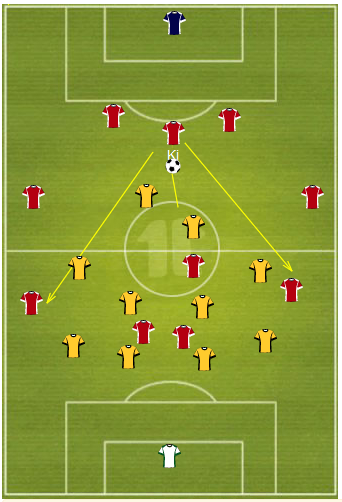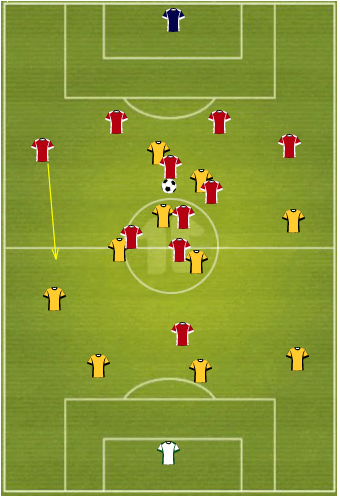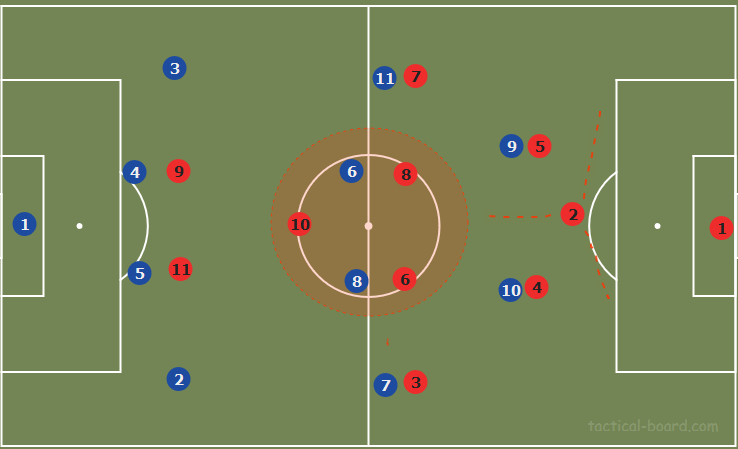
In Part 1, we took a look at how Sweden will set-up and what their strengths are. A quick recap: they’re deep and compact in their defensive 4-4-2 shape, will go route one to their two tall centre forwards and work hard for the second ball, and use Emil Forsberg, their playmaker, in a more central role in order to provide some variety and continuity to their attack.
Korea has traditionally struggled to break down teams that seek to play stern defensive shapes. Numerous examples that easily come to mind include the 1-0 loss vs Tunisia in 2014, the numerous losses to Iran over the past few years and the 1-0 loss vs Honduras at the 2016 Olympics. Of course, a feature of all of those teams were that they were able to break at pace, something which eludes the Swedes, and will make things particularly interesting. With both sides wanting a win to give themselves a fighting chance in this difficult group, it is possible that Sweden could open up a little bit to chase a win.
However, we’re going to assume that Sweden starts their match in their usual defensive shape and structure (a safe assumption). What approaches can Shin Tae-yong take from the get-go, and what are the weaknesses and strengths of each?
In truth, I’m not very comfortable with defensive tactics, so a lot of this is asking – how do we break down Sweden? What kinds of ideas could play some sort of a part in that process? Of course, this is extremely far from exhaustive and just a few elementary tactical musings from a guy on his sofa. Take it with a grain of salt.
Using Ki Sung-yueng’s long-range passing / shifting play effectively
Something that Korea has often tried to do against these teams is best use the abilities of Ki Sung-yueng. Ki of course is an able passer, and with Sweden likely to concede possession, or at least unlikely (due to their approach) to retain very much of it or press hard for it, Ki becomes a very important player. His ability to spread passes out wide and hit effective diagonal long-balls may prove fundamental.
In fact, Korea may be tempted, instead of trying to play through Sweden’s defensive block centrally (which Denmark failed to do in their pre-World Cup tune-up despite boasting the talents of Christian Eriksen) to try and stretch Sweden out wide. Doing this of course requires Ki to be on his game.
But because Sweden often doesn’t try to block the direct pass from the fullbacks to the wingers, a perhaps more compelling and important option for Korea is letting Ki drift into the half-spaces in a deep position before switching the play, something like this:
By threatening to move up on one flank, and giving the ball to Ki, Sweden will have no choice but to shift over to the ball-side, leaving a winger unmarked. Though it’s not reflected in the graphic above, the two Korean forwards have a very important role to play in this also – they need to give the Swedish leftback enough reason not to play in a position closer to the Korean winger.
The strengths of this approach are that they are simple, and they are relatively safe. Korea’s two centre-backs like having the ball, and Korea has mobile players that can dribble at pace, more specifically Son Heung-min and Lee Seung-woo. Ki Sung-yueng’s distribution has been the hallmark of this team, and he is already well acquainted with dropping in between the two centre-backs – or heaven forbid, playing as a central centre-back – to collect the ball. It’s also remarkably pragmatic, which perhaps is something Shin Tae-yong needs at times instead of his inclination for eccentricity.
The downside? It’s very predictable, and probably easy to defend against. Sweden concede the wide spaces on purpose, and they have shown that they are able to deal with them. Lustig especially is a full-back that seems unlikely to get skinned on the right side, and in any case, effective dribbling requires players who are able to generate acceleration and pace. My real worry is that Sweden leaves no space behind them and it is difficult to find pockets of space against them to run into. Also, punting a diagonal ball and asking a player to turn on the engines from a static position is probably too obvious and simplistic.
Nonetheless, regardless of shape or playing personnel, it’s important to try and use Ki’s distribution as a way to bypass the central block. The wide players will need to have good first touches and be ready to threaten, while Ki will need to have a good day. If Sweden overadjusts to any wide threat, space is opened up centrally and in between the lines in Sweden’s half – something Korea will need to do seize as it is not an opportunity that is afforded too often.
Disrupting Sweden’s shape with our mobility
Those who may have watched the Peru vs Denmark match may have seen in Peru some of Korea when they are at their best. Their mobility, movement and patterns of play seem similar to a Korean offense that is clicking in a solid structure. Peru’s attack was fluid and flowing among the front players, with the midfielders only there in support.
In the scenario above, Peru have disrupted Sweden’s system, and it’s not because of enormous complexity. Sweden faithfully sticks to that two banks of four system which means it’s not too difficult to try and manipulate them with Korea’s mobile players. A fullback pushing for an overload, a central midfielder (in Korea’s case, Son or Hwang) vacating the middle of the pitch and suddenly a pocket of space open up for the ball-carrier to run into. Sweden are no longer compact.
If we were to transpose the situation above to a Korean context, you’ve got either Lee Jae-sung or Lee Seung-woo on the ball in this scenario. Lee Jae-sung is going to thread the needle and try to pass it to the forwards, while Lee Seung-woo will sprint into space (and perhaps look for a foul).
If Korea plays a 4-4-2, scenarios like this where interchanging, overloads and vacating spaces for teammates are essential. Peru found lots of positive examples of success against Sweden while doing this (they were unable to apply the finish in that game, much like today against Denmark).
Exploiting the left channel
As discussed in yesterday’s post, Emil Forsberg likes to drift inside, either to try and dribble through players or as the recipient of the second ball in a central position. Either way, his listing as a left midfielder on Monday is purely on paper. This does mean that there are scenarios were there is a gaping hole on the left side.
In this scenario from yesterday, Forsberg’s moving inwards has forced the Swedish left-back to push upwards to fill in the space. However, if Korea were to win the second ball in this situation, it would be wise, given Sweden’s disorganized state at the team (and how hard it is to break them down when play is static) to attack the Swedish left-back on a 1v1. Naturally, this means that the responsibilities will fall to the Korean right-back.
Lee Yong has said that he is confident and ready to mark Forsberg out of the game as well as attack the space he leaves behind. On the podcast that we’ll put out a little later, I do advocate in favor of starting Lee Yong (or at least seem indifferent to it). On more reflection I think that was a mistake. In the Korean side, the player that can help man-mark a vital, pops-up everywhere kind of opponent and furiously attack defenders on the overlap is Ko Yo-han. We saw how he marked James Rodriguez out of the game against Colombia with frustrating tackles and fouls – that kind of snippiness could be useful against Forsberg. But more importantly, in a pure head-sprint, Ko Yo-han is better than Lee Yong. In terms of adding more complexity and fluidity to the attack from the wing-back position, Ko Yo-han is better than Lee Yong. Though Lee Yong may be a better crosser, when you take into account that Sweden is a defensive side that doesn’t have much of a record to point to on the counter-attack, it may be wise to call on the more attacking full-back in Ko in this game.
Copycat Sweden? The Role of a Central Forward
This is the kind of result I dread Korea will resort to. Not least because Lee Yong has been talking a lot in the media about marking Forsberg, and Shin Tae-yong starting Kim Shin-wook in the last two friendlies (though that may have been part of the trick? Who knows…). I don’t feel it’s really necessary to draw it out with pictures and images, because you can kind of get the drill. Ki Sung-yueng (as above) will drop between the centre-backs. He’ll punt a longball to Kim Shin-wook. If Kim wins it and Korea recovers the second ball, you’ve got a disorganized Sweden anda situation perhaps for Son perhaps to exploit. In a similar situation, Korea threads a few passes together and creates space wide. Either full-back crosses the ball into the box from a deep position to Kim Shin-wook.
The upside is that regardless of formation, given Sweden’s inability to counter or be very creative through the center of the pitch quickly, Korea should remain solid in terms of overall shape. You’re not asking players to pull their markers in any direction or create as many overloads. It’s back to basics, and defense-first. It’s something we know the players can do.
The downside is the obvious – Kim Shin-wook as a center forward against Granqvist and Lindelof won’t work in terms of 1v1 duels. There’s actually not a single chance in the world it does, and Korea will remain painfully anemic. The only hope is that he’ll occupy one and force them to think a little. However, what’s not to say they won’t remain as anemic and ineffective with young (and not the most tactically intelligent) players like Hwang and Lee SW trying to distract Sweden’s defensive superiority?
4-4-2 or 3-5-2?
One thing is true. There are some specific similarities between these shapes on paper in that Korea will at times look very 3-5-2-y even when listed as a 4-4-2. Ki Sung-yueng dropping deeper to collect the ball, with the full-backs pushing high up – looks like 3-5-2. Lee Yong/Ko Yo-han attacking the space in behind Forsberg – looks like 3-5-2. Korea defending against the second ball? Going to look like many things, but definitely not 4-4-2.
Two major points however will be the 3-5-2’s natural tendency to “neutralize” 4-4-2 and who Korea elects to use in the wide spaces when attacking.
As we discussed in a previous post, the 3-5-2 v 4-4-2 battle, when solely used on paper, gives the red team in the diagram above an extra man at the back and an extra man at the middle while still marking the wide midfielders. (Given our defensive frailness, an extra man at the back is theoretically a very good thing against two tall CFs). This is why Shin Tae-yong has been trying so stubbornly to make it work.
Though I heavily criticized Shin’s use of the 3-5-2 against Bosnia (pacey Bosnian wingers with lots of space behind the defense and no wing-backs tracking back? no thanks), Sweden is a very different opponent. This may bite me in the behind, but taking mild risks against Sweden that don’t leave you too exposed is an infinitely better approach than replicating their style of play simply because Sweden are not built to counter attack. So, praying that our wing-backs and defensive positioning holds up in exchange for a 3-man midfield may be something that’s worth considering.
Given that Sweden likes to commit 5 players to their long-balls – the two CFs, the two CMs and Forsberg – Korea will need to match that with 5 players of their own. Obviously the two Korean CBs will pick up the two Swedish FWs and let’s just say the two Korean CMs will pick up two Swedish CMs. Which leaves Forsberg, arguably Sweden’s most dangerous player in this scenario. If Korea plays a natural 4-4-2, you’re probably asking either a fullback to join the fray (and leave space behind) or a wide midfielder – Lee Jae-sung or Lee Seung-woo – to play a meaningful part in a situation where physicality is of the essence. Neither Lee excels in that department. Playing a 3-5-2 would allow for a 3-man midfield of say Koo-Ki-Jung. Obviously Koo is better equipped in this kind of messy, physical situation than anyone else.
However, the major downside to the 3-5-2 for Korea is that it forces natural wide players centrally as well as sacrificing Korea’s more talented players. A midfield trio of Koo-Ki-Jung means no Lee Jae-sung. It also makes Kim Min-woo/Park Joo-ho and Ko Yo-han/Lee Yong more important as the players who will need to position themselves well to stretch Sweden and cross into the box. Anything to make our poor wingbacks more important seems like fitting players into a system, not fitting a system to the players. Also, I just said crosses and that means Kim Shin-wook from the start which… promises to do little in any case.
So, there’s a case for 3-5-2 – it offers defensive stability and a response to a part of Sweden’s strengths, but also makes your 0-0 prediction on the FIFA Prediction game really probable.
What would I do?
I think upon talking with the Tavern crew (esp. the tactical savant Jae Chee) I’d probably play a 3-5-2 to start, and yes, with Kim Shin-wook up top. I don’t think I would drop Lee Jae-sung, because his creativity is important and can give a two-top pairing the Wookie-Son to think twice about. The aim is to see if we can cope with Sweden’s directness and see also if Wookie can at least keep one centreback busy. I don’t expect him to be winning many long-balls, though. If the score remains at 0-0, then I would maybe withdraw Koo Ja-cheol and the 3rd CB (Jung Seung-hyeon or Yoon Young-sun?) around the 60th minute and bring in Lee Seung-woo and Hwang Hee-chan progressively to try move back to more of a 4-4-2 shape. Sadly, I’ve been convinced by the argument that Korea in this game at least needs to use their one centre forward.
—
Obviously, of these many approaches, a combination and variety of them and important. Sweden’s compact structure will not be breached by repetitiveness, but instead by teams doing many different things in order to draw them out. They’re not invincible. Korea just needs to offer more than it has in previous friendlies, and a win is not out of reach.






Welp… Shin Tae Yong is certainly saying “interesting” things again. Here we go with the shirt switching tactics. And now he’s gone out and said Europeans can’t differentiate Asian players (even though… that’s the scout’s job?).
We’ve noticed how weird some of his decisions/quotes have been the past month. And now it seems like most of the European and Spanish-speaking population have realized it. He’s getting obliterated all over the media right now. All I’m gonna say is he’d better prove the haters wrong tomorrow or he’s gonna have problems.
I’ve been cautiously optimistic since the draw, but now… eh… I just hope the players can hold their heads high. Not a fan of Shin Tae Yong now (I was when he got hired!), so I’m hoping he will actually surprise me tomorrow.
By the way, awesome write-ups Tim! Normally they would be getting me super excited, but the circumstances surrounding this WC make me less so.
Yeah STY needs to talk less LOL. the more he says, the more he comes off as an ajusshi who knows nothing about football. (and in that sense, somewhat lovable?). he’s really eccentric in that way haha.
thanks for the compliments! but you’re right, it’s been difficult to write without hope of anything. but maybe we’re wrong?